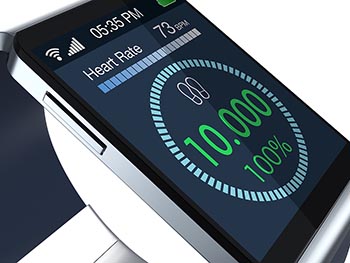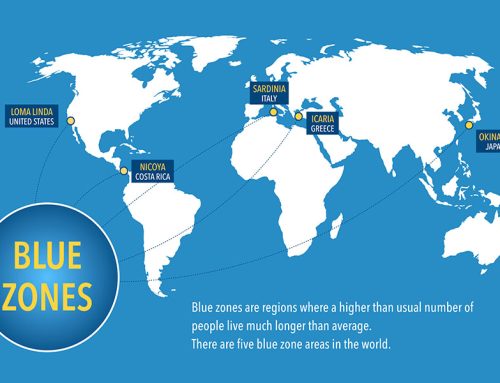If you’re interested in health, fitness and staying lean, then you’ve undoubtedly heard that 10000 steps a day is a good goal. It definitely shows that you’re active and not sedentary and it decreases your risk of health problems and an early death. But recently, there’s been skepticism over the popular 10000 steps a day goal. You may have seen articles in the last few years suggesting that 10000 steps a day was only a marketing ploy started in Japan back in the 1960s to promote pedometers (step trackers).

It may actually be true that the 10000 steps goal was invented as a promotional tool before there was much science to back up this guideline. But afterwards, the claim that 10000 steps a day is good was studied and the science did confirm it. 10000 steps a day is a reasonable goal to strive for if you want better health. We’ve also learned from the research that taking less than 5,000 steps a day (sedentary) is potentially very unhealthy.
10000 steps a day may not be the perfect goal for everyone. There is evidence that you can get significant health benefits at around 7000-8000 steps a day. Also, people who are extremely inactive can benefit simply from increasing their steps beyond where they are now.
And if you’re already highly active, you might want to challenge yourself with a step goal beyond 10000 a day. Maintaining more than 12000 steps a day is no small feat, but major fat loss benefits can really start to accrue when you get up around 12000 to 18000 a day. (As long as you don’t eat more as you step more – that mistake is known as “compensatory eating” and it’s why a lot of people don’t lose more when they step more…. “Oh look! I walked 15,000 steps today! I deserve some donuts!”)
If you know you should exercise more, but struggle to find the time or motivation, tracking steps can be a great way to do it. It’s simple and requires no equipment except a tracker or smartphone. It also doesn’t require lung-searing HIIT cardio, pavement pounding running, exhausting circuit training, or rhabdo-inducing CrossFit WODs.
Walking more and tracking your steps is an easy – and even fun – way to get motivated to move more and burn more. You can literally get started today right after you read this, and you can do it well by following my 3 simple tips below. As I explain each one, I’ll also show you some of the evidence for why 10000 steps a day really is a good goal.
1. Increase your activity by setting a daily step goal.
Did you know there’s an official “hierarchy of stepping?” Here it is:
1. 5,000 steps per day or less (sedentary)
2. 5,000 – 7,499 steps per day (low active)
3. 7,500 – 9,999 steps per day (somewhat active)
4. 10000 – 12,499 steps per day (active)
5. 12500 steps per day or more (highly active)
This comes from the research journals, not from the fitness tracker industry.
In the research, low step counts are associated with diabetes, high blood pressure, heart disease, obesity and yes, even early death. It may sound sensationalistic, but if you see an article or book that says “sitting kills” it’s not wrong.
A systematic review of 14 different studies with 280,000 participants found that all cause mortality was 11% lower for people who met established walking goals. It also found the benefits came in a dose-response relationship, with people who were very sedentary getting the most benefits compared to people already highly active and going even higher. This gave us even more evidence that being sedentary is terribly unhealthy.
The study I’ve always found the most interesting is the one on the old-order Amish community. It was published in the prestigious journal Medicine and Science in Sports and Exercise and found that the average step counts were 18000 a day for men and 14000 a day for women (extremely high activity). The obesity rate among these Amish is nearly zero. And they don’t diet (they eat pies and all kinds of other goodies).
Health Risks Of Too Much Sitting
2. If 10000 steps a day is unrealistic for you, find your baseline and simply do more than that.
Is 10000 steps a day a good goal? Well, first, according to experts who created the hierarchy above, it makes you officially “active.” It’s a challenging, but achievable goal for most people. But if it seems unrealistic for you, please don’t get discouraged because 10000 steps a day is not the end-all-be-all of health goals. Simply do this: Find your baseline steps, and if they’re low, set a goal to improve above that.
A lot of people only get 3,000 to 4,000 steps a day. If they don’t track it, they might not even realize how inactive they are. This is why I recommend using a pedometer (step counter). Invest in a fitness tracker, or simply download a free app for your phone.
Once you’ve established your baseline, then an excellent goal is try to bump that up by 3000 steps a day, ideally walking at a brisk pace. If you were doing only 4000, aim for 7000. That’s going to improve your health and is still a success even though it’s not 10000. If you’re able to increase it all the way to 10000 or close to it later, great. If not, at least you’re no longer sedentary at 7000 and you’ve already improved a lot.
Research confirms that adding 3000 steps day is another good goal for improving health and here’s why: If you walk briskly – at least 100 steps per minute (which is not hard – it’s under 3 mph) – you can get those steps in 30 minutes. Do that 5 days a week and you hit 150 minutes. 150 minutes of moderate exercise a week is still the prevailing guideline for good health.
By the way, this is further evidence that getting close to 10000 steps a day is a good guideline. The average American takes 5000 to 6000 steps a day. Adding 3000 more puts that number up to 8000 or 9000. Very close. You’d be doing quite well at 8000 to 9000 a day. 10000 may be even better. 10000 also happens to be a nice round number with a nice ring to it, which is certainly a reason it’s promoted so often as a daily goal.
What if you’re so busy you don’t have that many 30-minute blocks? Studies also show that if you break it up into 10 minute bouts, you still get the same benefits. Almost any able-bodied person can find 10 minutes here and 10 minutes there.
Why don’t they? Maybe because the fitness industry has tried to program us to think you have to run for hours, or HIIT yourself to death, or spin til you puke to get fit and healthy. It’s just not true. For general good health, exercise doesn’t take that much time and doesn’t have to be an all-out effort.
There’s nothing wrong with intense cardio exercise if you can tolerate it or even enjoy it. Higher intensity training is both effective and time-efficient.
But walking is shockingly good for you too.
If you’re doing resistance training as well (lifting weights, etc) the results can be fantastic. And the lifting doesn’t have to take much time either, especially when you use efficiency programs like our best selling TNB TURBO workout.
The New Body TURBO (T.N.B. TURBO) Ultra Time Efficient Training To Build Muscle Faster
3. Make yourself accountable to your step goal.
Accountability produces tremendous motivation, compliance and consistency. Every good coach knows that as soon as you start tracking something that you want to improve, your performance improves, without a single other change. You can’t improve what you don’t even measure.
You start with accountability to yourself. Once you’ve set the goal, track your own steps with a fitness tracker of your choosing (or a free app with your phone).
Then become accountable to others. On apps like Fitbit you can invite your friends to step with you, keeping tabs on each other. If you’re competitive, it gets even more motivating, not to mention we need the social connection for our emotional health. (And socializing our fitness pursuits increases intrinsic motivation).
Using both self accountability and external accountability together is so powerful, that’s why I started sponsoring our own Burn the Fat, Feed the Muscle step challenges.
Burn the Fat, Feed the Muscle is a bodybuilding-inspired program, but I don’t believe in neglecting the cardio health side of things just for the sake of a sculpted physique.
My mission is to promote good health and peak fitness not just lean, muscled physiques, so I brought thousands of like-minded people together in an online forum. Then we all set goals, including stepping goals, and together, we encourage, motivate and support each other as we aim to reach them.
Everyone has different goals, but we named our event the 1 Million step challenge because it’s a 100 day contest, and if you do 10000 steps a day, that’s 1 million steps.
You might be thinking, “Sounds do-able! Sounds great! But these fitness challenges are always expensive.”
Maybe other fitness coaches charge an arm and a leg to participate in a challenge. Not this one. Our challenge is free.
For information on the next challenge that you can enter, visit The Burn the Fat Challenge contest calendar page here.
To your health,
Tom Venuto
Author, Burn the Fat, Feed the Muscle (BFFM)
Author, The BFFM Guide to Flexible Meal Planning For Fat Loss
PS. By the way, did you know that research also shows taking a walk is a proven way to kill sugar cravings? When you feel the craving, don’t act on it right away. Tell yourself you will take a short brisk walk (at least 10 minutes; 20-30 even better.). Tell yourself if you still feel the craving afterward, you’ll let yourself have the treat you want. Most people will find after the walk, the craving is gone. Chalk up another reason to step it up!
PPS. How many steps a day do you take? How many do you think is realistically sustainable? Share in the comments below.

Tom Venuto is a natural bodybuilding and fat loss expert. He is also a recipe creator specializing in fat-burning, muscle-building cooking. Tom is a former competitive bodybuilder and today works as a full-time fitness coach, writer, blogger, and author. In his spare time, he is an avid outdoor enthusiast and backpacker. His book, Burn The Fat, Feed The Muscle is an international bestseller, first as an ebook and now as a hardcover and audiobook. The Body Fat Solution, Tom’s book about emotional eating and long-term weight maintenance, was an Oprah Magazine and Men’s Fitness Magazine pick. Tom is also the founder of Burn The Fat Inner Circle – a fitness support community with over 52,000 members worldwide since 2006. Click here for membership details
Scientific References:
Basset, JR et al, Physical Activity in an Old Order Amish Community. Medicine and Science in Sports And Exercise, Sci. Sports Exerc., Vol. 36:1 79–85, 2004.
Basset DR, et al., Medical Hazards of Prolonged Sitting, Exercise and Sport Science Reviews, vol 38, No 3 pp 101-102, 2010.
Kelly P, et al. Systematic review and meta-analysis of reduction in all-cause mortality from walking and cycling and shape of dose response relationship. International Journal of Behavioral Nutrition and Physical Activity 2014, 11:132
Ledochowski L et al, Acute Effects of Brisk Walking on Sugary Snack Cravings in Overweight People, Affect and Responses to a Manipulated Stress Situation and to a Sugary Snack Cue: PLOS ONE, 10(3): e0119278. doi:10.1371/journal.pone.0119278, 2015
Tudor-Locke et al. How many steps a day are enough for adults? International Journal of Behavioral Nutrition and Physical Activity. International Journal of Behavioral Nutrition and Physical Activity, 8:79. 2011






Leave A Comment